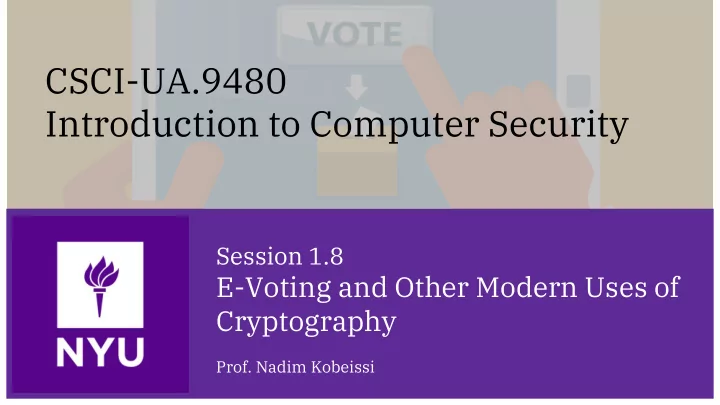

CSCI-UA.9480 Introduction to Computer Security Session 1.8 E-Voting and Other Modern Uses of Cryptography Prof. Nadim Kobeissi
1.8a Electronic Voting 2 CSCI-UA.9480: Introduction to Computer Security – Nadim Kobeissi
Properties of an traditional system. Availability: Voters can actually vote. ● Confidentiality: votes remain secret. ● Anonymity: Votes are anonymous. ● Integrity: Votes cannot be tampered with. ● In addition, separation of privilege and the ● general auditability of al processes in the system as well as the system itself are paramount. 3 CSCI-UA.9480: Introduction to Computer Security – Nadim Kobeissi
Traditional voting process. Source: Electoral Commission of South Africa 4 CSCI-UA.9480: Introduction to Computer Security – Nadim Kobeissi
So what’s the problem? Low turnout, as seen for example ● in the United States (source: fairvote.org) Expensive to organize. ● E-voting could allow for ● organizing more elections, delivering voting results more reliably… Widening access to voting? ● 5 CSCI-UA.9480: Introduction to Computer Security – Nadim Kobeissi
What about electronic voting machines? Very popular across the world, actually. ● In France: iVotronic , “Machine à voter”, ● “Point & Vote”… Potential issues: systems not open source, ● issues of public confidence… Attacks reported: “Alex Halderman and Ari Feldman ● replaced the voting software with Pac-Man. They did this in three afternoons, without breaking any tamper-evident seals. It would be easy to modify the software to steal votes, but that's been done before, and Pac- Man is more fun.” 6 CSCI-UA.9480: Introduction to Computer Security – Nadim Kobeissi
Swiss Post’s E -voting Solution. “ Data protection is guaranteed at all times: ● “ Cantons have complete control over the ● election process, which means that they can List of all voters remains the sole property of ○ guarantee their sovereign jurisdiction at all the canton. times.” All data and servers located in Switzerland.” ○ “Cantons can organize their own elections ● “ Voting secrecy is guaranteed at all times: ● and voting processes very simply. ” Based on a verifiable cryptographic protocol. ○ End-to- end encryption.” ○ “Guaranteed high level of availability. ” ● 7 CSCI-UA.9480: Introduction to Computer Security – Nadim Kobeissi
Swiss Post’s E -voting solution. 8 CSCI-UA.9480: Introduction to Computer Security – Nadim Kobeissi
Same security goals apply. Availability: Voters can actually vote. ● Confidentiality: votes remain secret. ● Anonymity: Votes are anonymous. ● Integrity: Votes cannot be tampered with. ● In addition, separation of privilege and the ● general auditability of al processes in the system as well as the system itself are paramount. 9 CSCI-UA.9480: Introduction to Computer Security – Nadim Kobeissi
Threat modeling for e-voting. Insider attack. ● Backdoored code. ● Flaws in code. ● Computer or server compromise. ● Denial of Service attacks. ● What about public confidence? Even a ● flawless election can result in a political crisis if the public doesn’t believe in the legitimacy or credibility of the process. 10 CSCI-UA.9480: Introduction to Computer Security – Nadim Kobeissi
So is e-voting even worth it? Debate has been ongoing but was recently ● reinvigorated by the Swiss Post public audit and penetration test initiative. Bryan Ford argues that it’s worth it → ● ● “International scrutiny of E - voting systems like Switzerland’s is extremely important and welcome. But simplistically opposing all E-voting, on grounds of complexity or failure to solve problems like vote-buying that alternatives like postal voting have too, is counterproductive. The only way to solve critical open security challenges like vote-buying is to press forward and work to advance the state-of-the-art further, not retreat to a techno-luddist position that any voting method using paper is automatically more secure than any method using electrons.” 11 CSCI-UA.9480: Introduction to Computer Security – Nadim Kobeissi
Computing on encrypted data. Homomorphic encryption allows computing ● on encrypted data without decrypting it. For example, Alice can add E(K,1) to ● E(K,5) without knowing K , and obtain E(K,6) . Source: Orange Labs 12 CSCI-UA.9480: Introduction to Computer Security – Nadim Kobeissi
Applications to e-voting: referendum case. “Yes vote” = 1 and “no vote” = 0, ● Each voter encrypts her vote using the ● tallier’s public keys. The voting center computes an encryption of ● the sum of the votes thanks to the properties of the homomorphic encryption scheme. The tallier decrypts this ciphertext and ● obtain the outcome of the election. No individual vote is revealed! ● Source: Orange Labs 13 CSCI-UA.9480: Introduction to Computer Security – Nadim Kobeissi
What about coercion, remote impersonation? To mislead a coercer, the voter sends invalid ● ballot(s) as long as he is coerced, and a valid ballot as soon as he is not coerced. It suffices that the voter finds a window- ● time during which he is not coerced. Source: Orange Labs 14 CSCI-UA.9480: Introduction to Computer Security – Nadim Kobeissi
ElGamal is partially homomorphic. Secret key: x Public key: (G, q, g, h = g x ) Source: Wikipedia 15 CSCI-UA.9480: Introduction to Computer Security – Nadim Kobeissi
Looking at Swiss E- voting’s cryptography. Uses ElGamal. ● Uses zero-knowledge proofs of knowledge ● (proving that you know x to a verifier without either party revealing anything about x). Read the whole thing here: ● https://www.post.ch/- /media/post/evoting/dokumente/swiss- post-online-voting-protocol.pdf 16 CSCI-UA.9480: Introduction to Computer Security – Nadim Kobeissi
Swiss E-voting protocol workflow. 17 CSCI-UA.9480: Introduction to Computer Security – Nadim Kobeissi
Swiss E-voting protocol workflow. 18 CSCI-UA.9480: Introduction to Computer Security – Nadim Kobeissi
Swiss E-voting protocol workflow. 19 CSCI-UA.9480: Introduction to Computer Security – Nadim Kobeissi
Next time: Networking 2.1 Basics, TCP, IP and DNS The first session in Part 2 of our course: Network Security. 20 CSCI-UA.9480: Introduction to Computer Security – Nadim Kobeissi
Recommend
More recommend